|
|
|
|
|
|
 Name: The Romanian name is Braşov, the 'ş' is pronounced as [ sh ].
The German name is still often used as well: Kronstadt, the Hungarian name is
Brassó.
Location:
Around 170 km north of →Bucharest in the south-west
corner of Transylvania (also known under its German name Siebenbürgen).
Brasov is surrounded by the Carpathian mountains, making it the perfect base for
extensive hiking tours.
Population: around 320,000. Hence Braşov is the
sixth largest city of Romania.
Orientation:
The compact historic centre of Brasov is surrounded by hills and mountains
and offers the well-preserved atmosphere of a medieval German town.
The outskirts are completely different and dominated by dull concrete apartment blocks
and crumbling industrial complexes. The new economic centre of the town concentrates around the
train station. From the train station to the old town centre it's a brisk 30-minutes walk.
Name: The Romanian name is Braşov, the 'ş' is pronounced as [ sh ].
The German name is still often used as well: Kronstadt, the Hungarian name is
Brassó.
Location:
Around 170 km north of →Bucharest in the south-west
corner of Transylvania (also known under its German name Siebenbürgen).
Brasov is surrounded by the Carpathian mountains, making it the perfect base for
extensive hiking tours.
Population: around 320,000. Hence Braşov is the
sixth largest city of Romania.
Orientation:
The compact historic centre of Brasov is surrounded by hills and mountains
and offers the well-preserved atmosphere of a medieval German town.
The outskirts are completely different and dominated by dull concrete apartment blocks
and crumbling industrial complexes. The new economic centre of the town concentrates around the
train station. From the train station to the old town centre it's a brisk 30-minutes walk.
Getting there: All international trains running from Vienna and
→Prague via
→Budapest to →Bucharest
stop in Brasov. From Brasov to Budapest it's around 12 hours only.
Many daily trains, express trains as well as local trains, connect Brasov with the capital.
The rapid train needs two to three hours, the fare is 185,000 Lei (around € 5).
Buses running to Bran Castle and to
Râşnov Castle leave from the bus station (autogara) on the corner of
Avram Iancu and Sportul Popular. The bus station is around 20 minutes away from the train station
on foot. Countless buses and trains connect Brasov with Sinaia. The ride
takes around 30 minutes, buses leave from the square in front of the train station.
Bus No 4 runs between the train station and the old town. This takes around
10 minutes, the fare is 7,000 Lei (tickets have to be bought beforehand - at kiosks, for example)..
|
|
|
|
|
|
|
The main attraction of Braşov is the entire historic old town centre. The town was founded by German settlers in the
12th century. Ever since, it was known as Kronstadt. Although the town and the surrounding area never
belonged to Germany, it was heavily influenced by Germans during the next centuries. Later on, Hungarian settlers came to
Brasov and left their traces as well. The central square of the old town is called Piaţa Sfatului (Council Square). It could be
the market square of any German town as well.
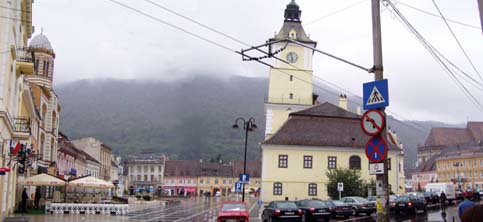
| |
Council square (Piaţa Sfatului) of Brasov...at filthy weather
|
'So why are all the people going to Braşov in Romania - in order to see a typical German market square!?' might the unbiased
observer curiously ask. A good question. It's probably not only because of the town but also thanks to the →surroundings
and the fact that Brasov is one of the best-preserved towns in Romania. The small mountain on the picture behind the square is called
Munţii Tâmpa. A cable car whisks visitors up to the top - I guess the view from there is quite nice,
provided that it's not pouring with rain as it did when we visited the town. The main shopping street of Brasov with numerous
shops and cafés is called Strada Republicii. This pedestrian zone starts at the central square.
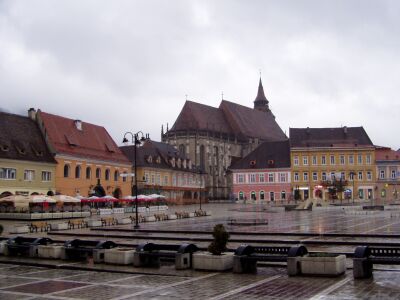
| |
The Biserica Neagră (Black Church)
|
The central square is dominated by the large Biserica Neagră (Black Church) at the southern corner.
This church is nothing less than Transylvania's biggest Gothic church. The walls of the church were blackened with soot during an
attack by the Habsburg (ie Austrian) army in 1689, A few hundred metres to the south you will find the interesting
Romanian-Orthodox Biserica Sfîntul Nicolae (St Nicholas Church), which was built in the 14th century.
Next to the church is a marvellous school - this was the first Romanian school and is now used as a museum.
Additionally, there are several interesting museums in the old town - among them the Muzeul de Istorie (Historical Museum),
the Muzeul de Artă Brasov (Art Museum), the Muzeul de Etnografie and the
Turnul Ţesătorilor. The latter was a bastion and has an impressive model of old Brasov on display.
|
|
|
|
|
|
|
Braşov is the ideal base for hiking and skiing in the area. Popular ski and hiking resorts include Poiana Braşov
(13 km) and Predeal (27 km) right in the middle of the bizarre Bucegi Mountains. Further to
the south there's a large and popular resort in and around Sinaia (appr. 50 km)
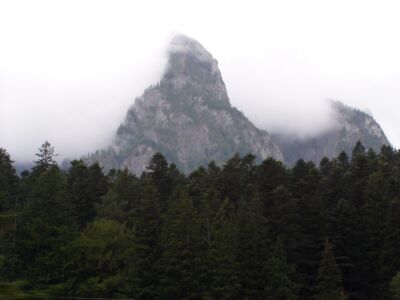
| |
The Bucegi Mountains between Predeal and Sinaia
|
Probably the most popular attraction with tourists is the Castelul Bran, which is around 30 km away to
the south-west. For some reason, the Bran Castle is also referred to as Dracula's Castle. If this was his castle, he must have been a
real cutie. The small castle is full of tiny rooms, stairways and corners and was probably built at the end of the 14th century. Today it
houses a museum. After climbing a steep slope, you will encounter an aha-experience: Aha, the effort was absolutely worthless!
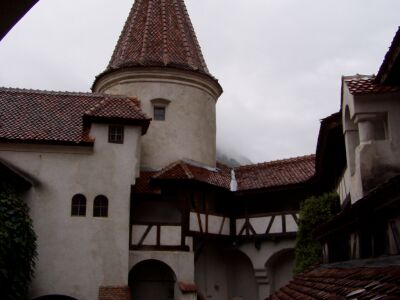
| |
Inside Bran Castle
|
Sure the castle is nice and scenic, and obviously the PR gag with Dracula seems to work - countless tourists roam the
narrow corridors. However, chances are low that Vlad Tepes had ever been to Bran. To call Bran Castle a Romanian
must-see is definitely an exaggeration. Below the castle, there's a small market where kitschy souvenirs, many of them
related to Dracula, are sold.
The Ethnographic Museum at the foot of the mountain is quite interesting. There, traditional farmhouses
from several provinces were rebuilt. It's possible to see parts of the interior as well.
Getting there: From Braşov it takes around 30 minutes by bus, the fare is 20,000 Lei (€ 0.5).
See general information above for information on the bus station in Braşov. It's more convenient (but more expensive) to join a tour.
Admission fee: 70,000 Lei (students, ISIC-card necessary, pay 30,000 Lei).
Far more interesting than Bran is the Peasant's fortress of Râşnov (pronounced Reshnov),
which is also known under its German name 'Rosenau'. The fortress towers high above the village with the same name.
There are two ways to climb the fortress, but the shortest and quite steep path is a little bit hard to find.
As soon as you approach the main entrance, you will hear classical music.
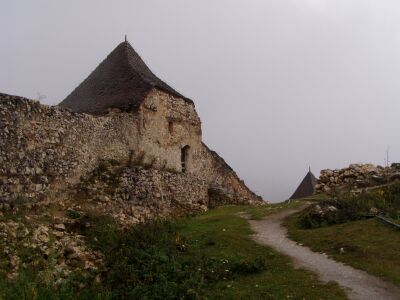
| |
The fortress of Rasnov (Rosenau). The genuineness is just charming
|
Step in and you will be very surprised. Rasnov is indeed a real peasant's fortress, containing several farmhouses, stables and a small
church. The fortress was built during the 13th century. The front wing contains a small exhibition with several pictures from the
good ol' times - among them frightening drawings depicting the act of the once popular impalements.
It's fun to walk around the narrow lanes inside the fortress. There's a small, bare hill in the middle of the fortress, offering a
great view over the area incl. Brasov.
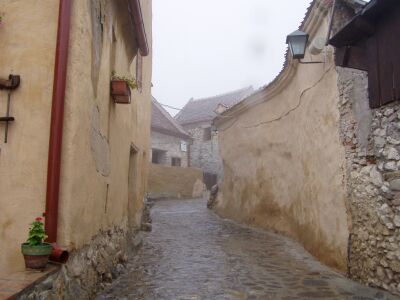
| |
Small lane inside the fortress Rasnov
|
Parts of the fortress are under reconstruction. However, wide parts are not restored and partially crumbling.
This is exactly what Rasnov makes a very charming place. Personally, I hope that the Romanians do not restore
more than absolutely necessary - if they do, it might soon look like a historic disneyland, ie like Bran.
If you're hungry after the climb, you might opt for a meal in Restaurant Intim (which means 'intimacy' -
sounds like a 'massage parlour') at the foot of the hill. The restaurant is close to the starting point of the shortest way
to the castle, and there are signposts showing the way. Restaurant Intim offers traditional Romanian food for little money.
Getting there: Rasnov lies halfway between Brasov and Bran and therefore it's perfect for
a stopover. It costs 10,000 Lei to get to Brasov as well as to Bran, the ride takes 15 minutes. The fortress is clearly visible
from the bus station (to the right when coming from Bran).
Admission fee: 45,000 Lei (no student's discount). A photo permission, really a bad habit, costs
an extra 30,000 Lei. However, it's a wide area so it's not really necessary to obtain a permission.
|
|
|
|
|
|
|
When you arrive in Brasov by train, chances are high that you run into Maria and Grig Bolea.
The 45? 50? years old couple spends every free minute at the train station looking for backpackers. Maria speaks
English fairly well, and she also knows some German, Japanese etc. And she's extremely talkative. She'll also
give you the feeling that it's the very first time that you've left the nest. Maria even starts calculating how much
money you'll need and so on and so forth. However, she's very nice (and so is Grig, but he doesn't talk a lot - how could he),
and the apartments they offer are spick and span. Rooms are spotless clean and feature a nice bathroom, a kitchen and so on.
A night in one of their rooms will set you back € 10 per person. It's like having your own apartment, so you can do
whatever you want. Since the apartments have more than one room, chances are high that you will meet other travelers, too.
Of course there are other places to stay - incl. several hotels and a hostel (see link below). The hostel operates a
tourist information inside the train station. Maria and Grig's phone number is 0744 816 970. They can help in any case.
|
|
|
|
|
|
|
www.poiana-brasov.com
First hand information from the authorities about Brasov und Sinaia. In German and English.
www.brasovtravelguide.ro
The address makes it clear. Plenty of information on Brasov in English.
www.elvisvilla.com/brasov
Website of the Kismet Dao Villa formerly known as Helga Hostel...Online-Reservation is possible, too.
For all of those who need cable T.V. and kitchen imported from Germany (self-marketing) in Romania.
Do you have or do you know a good website about Braşov? Don't hesitate, let me know!
After checking it, I would love to add it to the link list.
Please note that commercial websites will be declined. For e-mail link see menu on the left.
|
|
| |